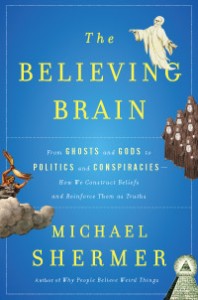Bring Your Questions for Skeptic-in-Chief Michael Shermer
Michael Shermer is perhaps the world’s only professional skeptic. As the founding publisher of Skeptic magazine and executive director of the Skeptics Society, Shermer has turned his innate skepticism into a full-time job. In our recent podcast “The Truth Is Out There…Isn’t It?” Stephen Dubner talks to Shermer about the evolutionary basis for our tendency toward “magical thinking” and why humans are conditioned to see threats often where none exist. Here’s an excerpt:
SHERMER: Our brains are designed by evolution to constantly be forming connections, patterns, learning things about the environment. And all animals do it. You think A is connected to B and sometimes it is, sometimes it isn’t, but we just assume it is. So my thought experiment is, imagine you’re a hominid on the plains of Africa, three and a half million years ago. Your name is Lucy. And you hear a rustle in the grass. Is it a dangerous predator, or is it just the wind? Well, if you think that the rustle in the grass is a dangerous predator and it turns out it’s just the wind, you’ve made a Type 1 error in cognition – a false positive. You thought A was connected to B, but it wasn’t. But no big deal. That’s a low-cost error to make. You just become a little more cautious and vigilant, but that’s it. On the other hand, if you think the rustle in the grass is just the wind, and it turns out it’s a dangerous predator, you’re lunch. Congratulations, you’ve just been given a Darwin award for taking yourself out of the gene pool before reproducing. So we are the descendants of those who were most likely to find patterns that are real. We tend to just believe all rustles in the grass are dangerous predators, just in case they are. And so, that’s the basis of superstition and magical thinking.
 Shermer’s latest book (his twelfth) is called The Believing Brain. Considered his magnum opus, the book synthesizes Shermer’s three decades of research to present a comprehensive theory on how beliefs are born, formed, nourished, reinforced, challenged, changed and finally extinguished. Shermer ranges across politics, science, sports and economics to look at how the brain manufactures beliefs first, then goes about building up explanations for them.
Shermer’s latest book (his twelfth) is called The Believing Brain. Considered his magnum opus, the book synthesizes Shermer’s three decades of research to present a comprehensive theory on how beliefs are born, formed, nourished, reinforced, challenged, changed and finally extinguished. Shermer ranges across politics, science, sports and economics to look at how the brain manufactures beliefs first, then goes about building up explanations for them.
Shermer has agreed to answer your questions. So, as always, fire away in the comments section, and we’ll post his responses in due course (here). To get you started, here’s the table of contents from The Believing Brain:
Prologue: I Want to Believe
Part I: Journeys of Belief
1. Mr. D’Arpino’s Dilemma
2. Dr. Collins’s Conversion
3. A Skeptic’s JourneyPart II: The Biology of Belief
4. Patterncity
5. Agenticity
6. The Believing NeuronPart III: Belief in Things Unseen
7. Belief in the Afterlife
8. Belief in God
9. Belief in Aliens
10. Belief in ConspiraciesPart IV: Belief in Things Seen
11. Politics of Belief
12. Confirmations of Belief
13. Cosmologies of BeliefEpilogue: The Truth is Out There
This post is no longer accepting comments. The answers to the Q&A can be found here.


Comments